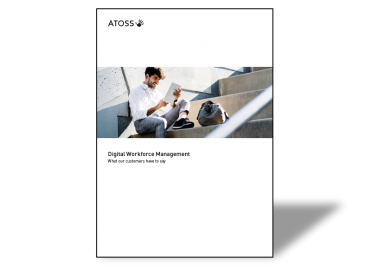Diversity – including the organization of working time
Diversity has been a hot topic discussed in HR circles for many years. Experts use the term to denote the elimination of discrimination and promotion of equal opportunities – regardless of age, gender, ethnicity, social origins or sexual orientation. And at ATOSS, we also take this issue very seriously. Since 2020, we have been a member of the Diversity Charter, a Federal Government initiative. ATOSS stands firmly for a culture of solidarity, acceptance and embraced diversity.
As a look at the corporate landscape readily reveals, a productive mix of younger and older generations, female and male skilled workers and an international workforce have long since become the order of the day. This is basically dictated by demographics and globalization. In 2017, the 50+ generation, also known as silver workers or best agers, already made up 70 percent of available workers. And this trend remains on the up and up.
In many sectors, e.g. public administration, water authorities or waste disposal, the number of 60+ employees is higher than one in ten. So the call for greater diversity in the corporate arena is almost a bit outdated. The challenge is more one of integrating the demands of different generations into everyday working life – for the benefit of companies and their staff.
Working time requests for every phase of life
The flexibilization of working time is no futuristic trend any more, but rather a daily reality and a suitable means of promoting diversity. Let’s take healthcare as an example, where we have an acute shortage of medical specialists. Many hospitals and care facilities have long since gone over to offering preferred schedules to enhance their attractiveness in the labor market.
Saarbrücken Hospital, a maximum care facility in the Saarland conurbation, has been offering preferred working hours for many years. The roughly 2,000 employees can adjust their volume of work to fit their personal situation within a defined framework three months in advance. For example, a full-time employee can lower their working time under collective agreements to 80 percent – for a fixed term, for at least half a year or indefinitely – and top it back up to 100 percent as and when required.
As an additional means to flexibilize working time, the hospital has introduced an overarching stand-in pool with more than 30 employees available to all wards. These predominantly female medical specialists are only available for shifts or days of the week they themselves have specified. Individual working-time models allow this top regional healthcare provider to guarantee highly reliable care – while at the same time making it an attractive employer.
Taking individual performance
The 50+ generation makes up the majority of today’s employees. Companies can benefit from their valuable experience if they incorporate such employees in their teams for specific tasks. Performance, however, often declines with age. In the industrial sector, but also in other physically demanding jobs, maintaining a healthy work-life balance is often more important these days than additional income. One thing is clear: If working time is organized to take account of employees’ current level of performance, companies will also benefit. The need to take time out or absence through illness decreases markedly, while the willingness to work an additional shift or stand in for a colleague at short notice increases.
One useful tool for giving employees greater leeway in organizing their working time is the so-called shift exchange. One beneficiary of this system, for example, is Medgate which operates Europe’s largest telemedicine center. The team consisting of 85 employees at the reception for patients, 22 telemedicine assistants as well as over 100 doctors, looks after and treats patients with health concerns round the clock, 365 days a year. By app, telephone or video. On peak days, the team copes with up to 5,700 calls. Staff at reception can swap their working times with colleagues on their own initiative using the shift exchange. Anything goes if it's what they want. The system automatically checks whether the few general conditions defined such as minimum assignments or the maximum working time of five consecutive working days have been respected in the exchange.
Deploying experience and skills for a specific purpose
Diversity means more than different ages, genders or cultures. In today’s knowledge-based societies the key issue is increasingly how the different strengths of employees can be combined for the benefit of the company. Valuable experience, skills and qualifications often lie dormant in personnel files. This hidden expertise within the company should be displayed transparently to managers and HR planners and made available. In this way, the knowledge of each individual employee can be tapped for the benefit of overall team performance.
Our customer J. Rettenmaier & Söhne has its qualifications and further training management firmly under control. This manufacturer assigns specific target qualifications to each sample workplace, and all employees are credited with their actual personal qualifications. Is the employee trained as a First Aid Officer and can they drive a truck? Do they have further relevant qualifications?
A target-actual comparison can be carried out automatically in the qualifications matrix. The organization of cross-departmental deputies was also simplified as the responsible foreman has an immediate overview of employees with the necessary multiple qualifications if faced with understaffing.
Workforce management is diversity management
Diversity in the company is only possible if the requirements of all employee groups are met. This also includes the employee-driven organization of working time. What’s more, digital workforce management allows innovative, multifaceted concepts to be more easily put into practice without losing sight of the statutory framework.


